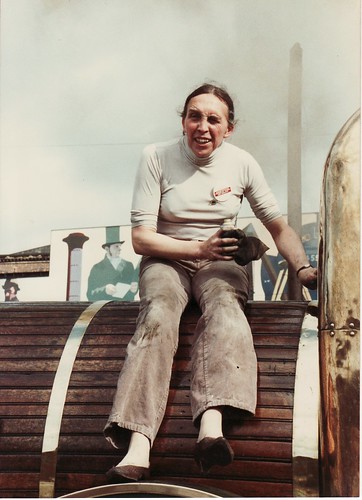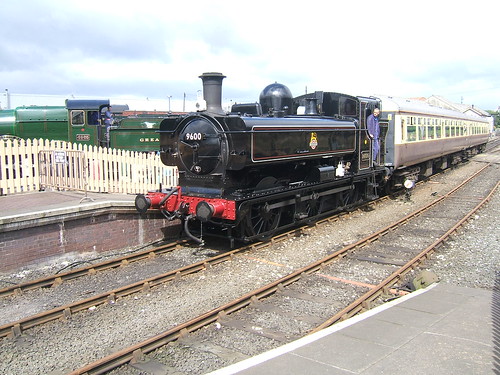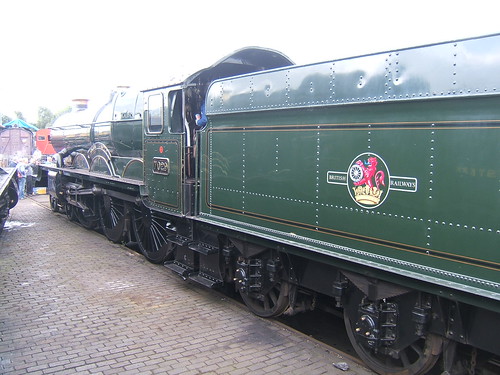
'Lion' at Manchester Museum of Science and Industry In 1988, with a much-younger Jan.
'Lion' had been returned to steam to celebrate her 150th Birthday (or, as The Old Locomotive Committee preferred to call it "The Sesquicentenary"), visiting various sites around the country. From Crewe, where I first became involved, she went to the Manchester Museum of Science and Industry, The Science Museum at Wroughton and made two visits to Birmingham Railway Museum, Tyseley. Having become a member of OLCO, I accompanied the venerable locomotive on these public appearances. During the visit to Tyseley, one of the OLCO members let on about my interest in railway signalling. Since the Museum's plans for a new demonstration line incorporating a Great Western signalbox (relocated from Holesmouth Junction) were well advanced, new volunteer members were being actively recruited for the Museum and I was invited - no, instructed - to join. Having had no previous involvement with railway preservation, I thus found suddenly found myself a member of three organisations - OLCO, the Manchester Museum of Science and Industry and Birmingham Railway Museum.
The two visits by 'Lion' to Birmingham Railway Museum after I joined OLCO produced some record crowds at Tyseley. Otherwise, things were much quieter apart from occasional 'Gala' days when two or three large engines would be steamed. Although the site was open to the public regularly at that time, the main activity during the week was restoration and repair of steam locomotives in the workshops. On Sundays, a 2-coach passenger train gave rides on the Demonstration Line using a small steam locomotive. For a time, a 'Terrier' carried out this duty. I'm afraid passenger numbers weren't impressive. The main excitement for operating volunteers was the regular, complicated shunts which were required to position vehicles for the workshops. Initially, I trained as a Passenger Guard and Shunter at the Museum and helped out a bit on the signalling side. Once the signal box was commissioned, I also passed out as a Signalman. The weekend passenger trains, which had previously loaded and unloaded at a wooden platform behind the signal box, moved to one of two new brick platforms, giving a somewhat longer ride.

9600 giving rides on the Demonstration Line during the 'Tyseley 100' event.
In an attempt to boost income, Driving Experience Courses were introduced. The original format proved very popular - a safety briefing, sessions about shunting, signalling and, with the benefit of a number of a number of locomotives under restoration to study, the principles of locomotive engineering. Most important, of course, was hands-on firing and driving on both a small tank locomotive and a tender engine, like 'Defiant' or 'Clun Castle'. There was a need for volunteers who could do the presentations on shunting, signalling and locomotive engineering and I happily served in this capacity for a while, before gravitating to Instructor Driver on the 'Little Engines' used on the Driving Experience Courses - engines like 'Henry', 'Cadbury No. 1' or one of the three Tyseley 'Panniers' (there's a description of 'Panniers' illustrating the Tyseley 'Panniers' here). The line used by the small engine was short but that gave trainees plenty of practice in starting, stopping and reversing. Each group of three trainees spent 75 minutes on the footplate, taking it in turns to drive and (if they wished) fire. The Instructor Driver 'single manned' and had to fire, manage the boiler and instruct and supervise the trainees.
But, of course, the highlight of the course was driving a large engine on the 400 yard demonstration line. Initially 'Defiant' or 'Clun Castle' were used and, again, the Instructor Driver 'single manned', looking after three trainees in each 75 minute session.

7029 'Clun Castle' running with a 'Churchward' tender.
The initiative met with such an enthusiastic reponse from enthusiasts that, later, a variety of engines offered the driving experience at Tyseley. By that time, I'd been 'passed out' to drive all visiting engines which included 'King Edward I', 'Taw Valley', 'Canadian Pacific' and 'Sir Nigel Gresley'. We thought we were busy with these locomotives on offer (which my friend Tony described as 'tasty engines') until driving courses on 'Flying Scotsman' were introduced.
To deal with the numbers of trainees who wanted a chance to drive this iconic locomotive, the course structure was simplified, omitting the presentations and the small locomotive experience and reducing the time each group of three trainees spent on the locomotive from 75 minutes to 60 minutes. Courses started earlier in the day and continued late into the evening. 12-hour shifts became common and I can remember disposing 'Flying Scotsman' at the end of a late-running shift at midnight, in a snowstorm! There's a short description of 'Flying Scotsman' at Tyseley here. As I write this, 'Flying Scotsman' has recently been returned to steam at a cost (this time) of £4.5 million. Commenting on the excitement this has caused in a post here I said "I think the opportunity for members of the public to actually drive 'Flying Scotsman' is unlikely to recur in the future".
I'll tell you more when I can, including the creation by Birmingham Railway Museum of 'satellite' courses at The Battlefield Line (resulting in my becoming a member of yet another preservation organisation). There's a short history of the Birmingham Railway Museum on Wikipedia here.
I remained a working volunteer at Birmingham Railway Museum for around ten years until Driving Experience courses were discontinued in favour of a regular steam service on the main line between Birmingham and Stratford, the 'Shakespeare Express', which commenced in 1999. Losing the opportunities for footplate work I'd come to enjoy, I decided to concentrate my activities at other sites - The Museum of Science and Industry (as the Manchester museum had become), The Battlefield Line and Peak Rail. However, I had an enjoyable day meeting old friends at Tyseley during the Tyseley 100 event in 2008.
